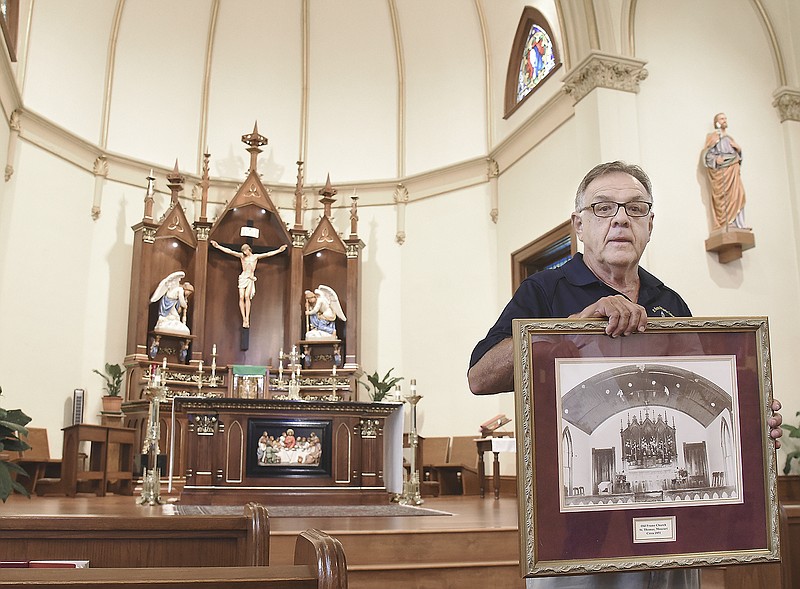When it came available, Tennessee land speculators bought up tracts of land that are now part of southeastern Cole County.
They waited.
Eventually, in the 1830s, migrants began arriving, searching for new lives and a place to worship the way they wanted.
Many, like the Leven family, who arrived in the area and bought land from the speculators, had left the Prussian Empire (Germany) and settled at Indian Bottom, between hills carved by the Osage River.
Seven families - at first - made up the Roman Catholic community.
One of the reasons for the Levens' immigration was to avoid having three sons drafted into the Prussian army.
The Rev. Ferdinand Helias, the recently appointed pastor of St. Joseph Parish in Wesphalia, made his first visit to Indian Bottom (about 1 mile west of what is now St. Thomas) to celebrate Mass in 1838, said Bill Boessen, who is on a committee organizing the 150th anniversary celebration for St. Thomas the Apostle Catholic Church.
At the time, St. Thomas didn't exist, Boessen said. Jesuit documents show the territory was known as Indian Bottom.
"(Helias) celebrated the Mass somewhere in Indian Bottom. We don't know if it was in people's homes, in the woods or wherever," Boessen said. "But that's when it all began."
The seven homesteading families built the territory's first log church in 1844 on a spot of ground that is now the cemetery property. Helias dedicated the log church in honor of St. Thomas the Apostle four years later. Over the next 21 years, missionary priests served the location.
And the congregation grew.
In 1853, the congregation had expanded to 21 families. They stick-built a church on the property alongside the log cabin.
However, trouble was brewing.
Jesuit documents say the church property bordered farmland owned by William Fluettemeyer.
Fluettemeyer wasn't happy about people passing over his land, Boessen said. Jesuit documents said the bachelor stood at the edge of his land holding a shotgun and guarded it against trespassers.
"In 1856, one day, he held people who wanted to go to church at gunpoint," Boessen said. "That's when the priest at that time - who was actually a missionary priest - Father Eysvogels, said, 'We can't have this. We're going to have to move the church.'"
About that same time, the town was starting to evolve a mile away.
Owen Riggs, a surveyor who had settled in Miller County, arranged to get some property in town where they could move the church.
The community disassembled the frame structure and the log church. They used the log church as a presbytery - where the priests would stay when they were going to celebrate Mass.
In 1869, Archbishop Peter Kenrick, of the Archdiocese of St. Louis, canonically recognized St. Thomas the Apostle Mission as an independent parish.
St. Thomas the Apostle is celebrating its 150th year as an independent parish Oct. 6. The event is very much a celebration of the parish, but also of the community.
The public is welcome to the free event, which is called the St. Thomas Heritage Celebration.
Mass will begin the celebration at 10 a.m.-6 p.m. Oct. 6. There will be an opening ceremony at 11:30 a.m.
The ceremony will include a flag-raising featuring local elected officials.
A church museum in the Parish Center (some people call it the gymnasium) will offer a chance for people to view photos and artifacts displaying the history of the church, including photos from the 1948 tornado that knocked the steeple off the structure, said Bill Lueckenhoff, one of the celebration organizers.
"Fortunately, all the stained glass windows were untouched," he said.
There will be walking tours of some of the historic sites in the town, led by Lueckenhoff and others.
There will also be tours of the historic cemetery - trolleys will ferry people to and from the cemetery, which is about a mile from the church.
Weatherproof displays will mark some of the historic locations.
There will also be tours of the parochial school.
Self-guided tours of the church, built in 1883-84, will be offered. The church contains an 1897 pipe organ and stained glass that is nearing 100 years old.
There will be a choir performance in the church during the afternoon.
Vendors will display their crafts outside the church - black-powder guns, blacksmithing, wood carving, fur trapping, square dancing and more.
Live German, bluegrass and country music will be performed.
A quilt show is planned for the event. There will be a petting zoo, bounce house and clown for children.
Food vendors are to be on hand, and there will be a beer garden.
Parish members spent three years producing a written history (600 pages including hundreds of photos) of the parish. Copies of "St. Thomas the Apostle Catholic Parish: Celebrating 150 Years, 1869-2019" are still available. For information about the book, call the St. Thomas the Apostle Parish office at 573-477-3315.
The Rev. Leonard Mukiibi, the church administrator, said he's captivated by the history of the town and the church.
Mukiibi, who is from Uganda, said St. Thomas the Apostle has existed since before Christianity took hold in his home country.
"I'm fascinated by the people - by the way they've preserved their faith," Mukiibi said. "You come here - it is 150 years over - and they still hold their faith. They are building on what was founded. It is really interesting and amazing."
On the web
For more information, visit stthomasapostle.net/sesquicentennial.html.

